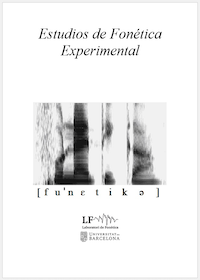Detailing the impact of social variables on the production of the Catalan mid-vowel contrasts by early Spanish-Catalan bilinguals
DOI:
https://doi.org/10.1344/efe-2024-33-57-68Keywords:
speech production, language contact, variability in production, mid-vowel contrasts, language-dominant groupAbstract
The present study investigates variability in the production of Catalan vowels by Barcelona young, middle-aged, and older adults who speak the Central Catalan variety. The degree of exposure to and use of Central Catalan varies among speakers as half of the participants are second-generation and subsequent-generation migrants from other regions of Spain, where the vernacular is Spanish. All speakers have been born, raised, and schooled in Barcelona, and have acquired both Central Catalan and Spanish. Central Catalan possesses two sets of phonemic mid-vowels (/e/–/ε/ and /o/–/ↄ/), unlike Spanish which has a single vowel per set (/e/ and /o/). This study aims to detail the Catalan mid-front and mid-back vowel contrasts used by speakers of different gender, age, language use, and exposure to Catalan from the bilingual speech community of Barcelona.
References
Amengual, M. (2014). The perception and production of language-specific mid-vowel contrasts: Shifting the focus to the bilingual individual in early language input conditions. International Journal of Bilingualism, 20(2), 1–21. https://doi.org/10.1177/1367006914544988
Birdsong, D., Gertken, L. M., & Amengual, M. (2012, January 20). Bilingual Language Profile: An easy-to-use instrument to assess bilingualism. COERLL. https://sites.la.utexas.edu/bilingual/
Blas Arroyo, J. L. (2011). Spanish in contact with Catalan. In M. Díaz-Campos (Ed.), The Handbook of Hispanic Sociolinguistics (pp. 374–394). Wiley-Blackwell. https://doi.org/10.1002/9781444393446.ch18
Boersma, P., & Weenink, D. (1992–2014). Praat: Doing phonetics by computer (Version 5.3.82) [Computer program]. http://www.praat.org/
Coates, J., & Cameron, D. (Eds.). (1989). Women in their speech communities. Routledge.
Cortés, S., Lleó, C., & Benet, A. (2019). Weighing factors responsible for the production of the Catalan vowel /ɛ/ versus /e/ contrast in three districts of Barcelona. International Journal of Bilingualism, 23(6), 1264–1277. https://doi.org/10.1177/1367006918781058
Evans, B. G., & Iverson, P. (2007). Plasticity in vowel perception and production: A study of accent change in young adults. The Journal of the Acoustical Society of America, 121(6), 3814–3826. https://doi.org/10.1121/1.2722209
Fabricius, A. H. (2008, September 16). Vowel normalisation in sociophonetics: When, why, how? [Conference presentation]. Sociolinguistics Circle, Copenhagen University, Copenhagen.
Foulkes, P., & Docherty, G. J. (1999). Urban Voices – Overview. In P. Foulkes, & G. J. Docherty (Eds.), Urban Voices: Accent Studies in the British Isles (pp. 1–24). Arnold.
Jespersen, O. (1922). Language: Its nature, development and origin. Allen and Unwin.
Kotsoni, Z. (2019). A sociophonetic analysis of the production of mid-vowel contrasts in Catalan spoken in Barcelona [Doctoral dissertation, Universitat Autònoma de Barcelona]. Tesis Doctorals en Xarxa. https://hdl.handle.net/10803/669724
Labov, W. (1966). The social stratification of English in New York City. Center for Applied Linguistics. https://doi.org/10.1017/CBO9780511618208
Labov, W. (1972). Some principles of linguistic methodology. Language in Society, 1(1), 97–120. https://doi.org/10.1017/S0047404500006576
Labov, W. (1994). Principles of linguistic change, Vol. 1: Internal factors. Blackwell.
Lobanov, B. M. (1971). Classification of Russian vowels spoken by different speakers. Journal of the American Statistical Association, 49(2), 606–608. https://doi.org/10.1121/1.1912396
Martínez Celdrán, E., & Fernández Planas, A. M. (2007). Manual de fonética española: Articulaciones y sonidos del español. Ariel.
Mascaró, J. (2002). El sistema vocàlic. Reducció vocàlica. In J. Solà, M.-R. Lloret, J. Mascaró, & M. Pérez Saldanya (Eds.), Gramàtica del català contemporani (pp. 89–123). Empúries.
Milà i Fontanals, M. (1861). De los trovadores en España. Estudio de la lengua y poesía provenzal. Librería de Joaquín Verdaguer.
Milroy, L. (1980). Language and social networks. University Park Press.
Montrul, S. (2016). Dominance and proficiency in early and late bilingualism. In C. Silva-Corvalán, & J. Traffers-Dallers (Eds.), Measuring Dominance in Bilingualism (pp. 15–35). Cambridge University Press.
Simonet, M. (2011). Production of a Catalan-specific vowel contrast by early Spanish-Catalan bilinguals. Phonetica, 68(1–2), 88–110. https://doi.org/10.1159/000328847
Tagliamonte, S. A. (2012). Variationist sociolinguistics: Change, observation, interpretation. Wiley-Blackwell.
Trudgill, P. J. (1974). Linguistic change and diffusion: Description and explanation in sociolinguistic dialect geography. Language in Society, 3(2), 215–246. https://doi:10.1017/S0047404500004358
Trudgill, P. J. (1983). Sociolinguistics: An introduction to language and society. Penguin.
Trudgill, P. J. (1986). Dialects in contact. Blackwell.
Van Coetsem, F. (1988). Loan phonology and the two transfer types in language contact. Foris. https://doi.org/10.1515/9783110884869
Wardaugh, R. (2002). An introduction to sociolinguistics (4th ed.). Blackwell.
Wolfram, W. A. (1969). A sociolinguistic description of Detroit negro speech. Center for Applied Linguistics.
Wolfram, W., & Fasold, R. W. (1974). The study of social dialects in American English. Prentice-Hall.
Downloads
Published
How to Cite
Issue
Section
License
Copyright (c) 2024 The authors

This work is licensed under a Creative Commons Attribution-NonCommercial-NoDerivatives 4.0 International License.
All articles published online by Estudios de Fonética Experimental are licensed under Creative Commons Attribution-NonCommercial-NoDerivs 4.0 International (CC BY-NC-ND 4.0 DEED), unless otherwise noted. Estudios de Fonética Experimental is an open access journal. Estudios de Fonética Experimental is hosted by RCUB (Revistes Científiques de la Universitat de Barcelona), powered by Open Journal Systems (OJS) software. The copyright is not transferred to the journal: authors hold the copyright and publishing rights without restrictions. The author is free to use and distribute pre and post-prints versions of his/her article. However, preprint versions are regarded as a work-in-progress version used as internal communication with the authors, and we prefer to share postprint versions.




